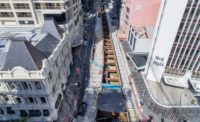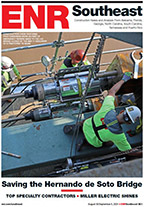Squeezing work on 12 bridges and numerous ramps into 18 months and just over a mile of congested urban corridor, the Colorado Dept. of Transportation is wrapping up a $98-million project along the busy U.S. 6 corridor in Denver. The design-build project has included an unprecedented complete weekend closure of Interstate 25 that eliminated 30 nights of lane closures.
Slated for completion in October, the project replaces six bridges and adds six more, including a pedestrian bridge re-linking sections of Denver’s Barnum Park. The park was bifurcated 65 years ago, when this section of the Sixth Avenue freeway was built west of downtown.
Highway improvements also include new ramp structures to accommodate traffic exiting and entering the highway while minimizing traffic weave movements and improving mobility through the heavily traveled Interstate 25/U.S. 6 interchange.
Adding to the degree of difficulty, the project is located along a congested 1.25-mile stretch of freeway, from Knox Court to the west through the existing U.S. 6 bridge over the Burlington Northern Santa Fe Railroad tracks just east of I-25.
“CDOT provided a base design to all bidders, and it was up to them to improve upon it,” says Bill Beams, principal and senior bridge engineer with Felsburg, Holt and Ullevig (FHU), the project’s lead design consultant. Plain, Wis.-based contractor Kraemer North America, with a regional office in Castle Rock, Colo., partnered with FHU’s Centennial, Colo., office to design and build the project.
“We think our improvements are why we were chosen,” Beams says. The Kraemer-FHU design-build team’s improvements include an enhanced ramp design for northbound I-25 to westbound U.S. 6 traffic—among the heavier ramp traffic movements, says Mike Ingram, senior project manager for Kraemer. “Rather than the basic cloverleaf ramp suggested in the CDOT RFP, we made a longer, more direct-connect ramp that connected to a westbound collector-distributor road that improved the flow of traffic,” Ingram says.
Beams says the simple, quick-construct bridges were designed to be built in two phases—instead of the typical three—to keep construction moving. During the proposal process, the team also found a way to save the project money by replacing an old bridge on Knox Court. That tactic allowed a better horizontal alignment for U.S. 6, increasing the proposed speed of the design.
Strategic Closures
CDOT and the design-build team worked collaboratively to minimize impacts for motorists, squeezing equipment and materials into tight staging areas. “Traffic [has been] one of our biggest challenges, along with the phasing that went with it,” Ingram says.
The volume of traffic on this major east-west thoroughfare—up to 10,000 vehicles per hour during peak periods—and its proximity to the city’s three major sports venues—Mile High Stadium, Coors Field and the Pepsi Center—affected construction, even when crews worked at night.
“We’re doing almost $100 million [worth] of work within a mile stretch of roadway, and it’s a very compact, congested area,” explains Kevin Sullivan, CDOT project director.
To kick-start the project, the team decided to close U.S. 6 in both directions over one full weekend in February 2014. “It allowed us to completely remove the existing median barrier, demolish the first two bridges at Knox Court and Federal, and install temporary asphalt pavement to move all the westbound traffic to the eastbound side to allow work to begin on the westbound side,” Ingram says.
Work was performed around the clock, from Friday night until 5:00 a.m. Monday morning—just in time for rush hour. Without the full weekend closure, the demolitions would have been done incrementally over several weeks.
In August, I-25 was closed over a weekend to demolish the U.S. 6 bridge over the Interstate, set girders for the I-25/U.S. 6 ramp bridge, install storm-drain crossings and overlay both directions of I-25 between Alameda and U.S. 6. I-25 was also re-striped to add an additional northbound lane.
“CDOT and the project’s public involvement team, CIG, blitzed the media several weeks in advance to advertise the upcoming closure. The Incident Management Team set up a command center at the Denver police station, manned by CDOT and … Denver traffic engineers, as well as construction management to monitor traffic backups on the multiple closed-circuit TV screens. This enabled decisions to be made to improve problem areas in a minimal amount of time,” Ingram says.
Work began on a Friday night but was actually completed around midnight Sunday, well in advance of the 5:00 a.m. start of Monday’s rush hour.
“We had never shut down I-25 before,” Sullivan says. “It took six weeks of planning, from Homeland Security, fire and police, to surrounding communities on the north and south, from Lakewood to Golden.”
As a result, 7,000 tons of asphalt, bridge demolition and other work that would have taken 30 nights of lane closures was completed in 36 hours—in all, approximately $1.5 million worth of work.
“We see 230,000 cars on I-25 daily, yet there were minimal backups due to traffic detours and great communication. It was a successful weekend closure,” Sullivan says.
Parks and Trails Work
Crews upgraded portions of the South Platte River Trail, which intersects U.S. 6 below the freeway, and built a new bicycle-pedestrian bridge over U.S. 6 west of Federal Boulevard. The bridge connects the Barnum and Barnum North parks to improve park access and safety.
Reconstruction of Denver’s Barnum Park (named for Barnum & Bailey Circus founder P.T. Barnum, who donated the land to the city circa 1900) included new sod and infield material for the baseball field. Crews also installed a new playground and multi-purpose, synthetic turf at Barnum East.
The project team worked closely with Denver City Councilman Paul Lopez to connect with the community throughout the project. CDOT, Kraemer and its subcontractors conducted neighborhood job fairs and trained disadvantaged businesses interested in working on the project. The design-build team also hosted a Thanksgiving food drive and lent support to the Sam Sandos Christmas basket program, which provides holiday meals to people in need.
In addition to CDOT, project funding came from the Federal Highway Administration, the city and county of Denver, and the Colorado Bridge Enterprise, a government-owned business enterprise within CDOT that was formed by state legislation in 2009 funded by vehicle registration fees.
Project Overview
Replacement of six structurally deficient bridges:
• U.S. 6 over BNSF Railroad
• U.S. 6 over I-25
• U.S. 6 over South Platte River






Post a comment to this article
Report Abusive Comment